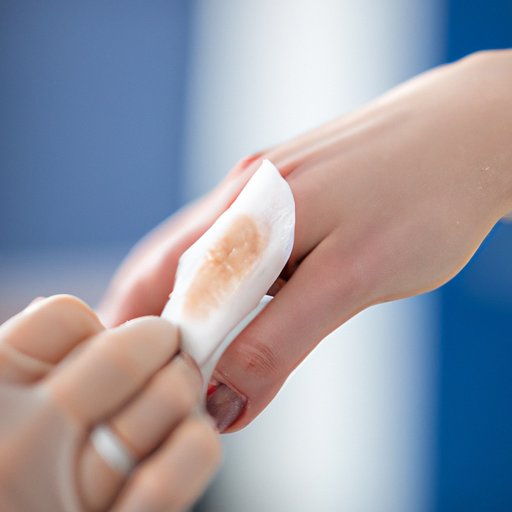
Introduction
Knowing how to properly clean a wound is an essential skill that everyone should have. Whether it’s a minor cut or a more serious injury, cleaning the wound properly can help prevent infection and promote faster healing. In this article, we’ll go over the five simple steps you need to follow to clean a wound effectively. We’ll also cover some dos and don’ts of wound cleaning, first aid specifics, natural remedies for wound care, and the science behind wound cleaning. So let’s get started!
5 Simple Steps to Clean a Wound and Promote Healing
Here are the five simple steps you need to follow to clean a wound properly:
Step 1: Stop the Bleeding
The first thing you need to do when cleaning a wound is to stop the bleeding. If the wound is bleeding heavily, apply firm pressure with a clean cloth or gauze until the bleeding stops. Elevating the wound can also help to reduce bleeding.
Step 2: Clean the Wound with Soap and Water
Once the bleeding has stopped, it’s time to clean the wound. Use clean water and soap to wash the wound. Make sure to gently remove any dirt or debris from the wound. Avoid using hydrogen peroxide or rubbing alcohol as they can damage the skin and delay healing. Also, avoid rubbing or scrubbing the wound as this can cause further damage.
Step 3: Apply an Antibiotic Ointment or Cream
After cleaning the wound, apply an antibiotic ointment or cream to the wound. This will help to prevent infection and promote faster healing. Make sure to apply the cream evenly and cover the entire wound surface.
Step 4: Cover the Wound with a Sterile Bandage or Dressing
Once the antibiotic ointment or cream has been applied, cover the wound with a sterile bandage or dressing. This will help to keep the wound clean and prevent further damage. Make sure to change the bandage or dressing daily until the wound has fully healed.
Step 5: Monitor the Wound for Signs of Infection
Finally, it’s important to monitor the wound for signs of infection. This includes redness, swelling, warmth, and pus. If you notice any of these signs, seek medical attention immediately.
The Dos and Don’ts of Wound Cleaning: A Comprehensive Guide
Here’s a comprehensive list of dos and don’ts when it comes to wound cleaning:
Dos:
- Use clean water
- Clean the wound gently
- Use disposable supplies
Don’ts:
- Use hydrogen peroxide
- Rub or scrub the wound
- Use dirty supplies
First Aid 101: How to Clean a Cut or Scratch
Cleaning a small cut or scratch is relatively simple. Follow these simple steps:
- Wash your hands with soap and water
- Clean the wound using clean water and mild soap
- Apply an antibiotic ointment or cream
- Cover the wound with a sterile bandage or dressing
- Monitor the wound for signs of infection
If the cut or scratch is larger or deeper, seek medical attention immediately.
Natural Remedies for Wound Care: Tips for Cleaning Cuts and Scrapes
Alternative options to antibiotic ointments or creams can also be used to help clean a wound. Here are some natural remedies that are known to be effective:
Honey
Honey is a natural antibacterial and anti-inflammatory. Apply a small amount of honey to the wound and cover it with a sterile bandage or dressing.
Turmeric
Turmeric has anti-inflammatory properties and can help to reduce swelling. Mix turmeric with water to form a paste and apply it to the wound.
Aloe Vera
Aloe vera has antimicrobial and anti-inflammatory properties that can help to heal wounds. Break off a small piece of an aloe vera plant and apply the gel to the wound.
From Bandaids to Bacteria: The Science of Wound Cleaning
When you get a cut or a scratch, your body immediately starts the healing process. This includes sending white blood cells to the wound to fight off infection. Cleaning the wound properly helps to promote healing by getting rid of any bacteria or debris that may slow down the healing process.
The Importance of Proper Wound Care: How to Clean Wounds to Prevent Infection
Cleaning a wound properly is essential to prevent infection and promote faster healing. An infected wound can lead to serious complications, including sepsis, which can be life-threatening. By following these steps, you can help to ensure that your wound heals properly and minimize the risk of infection.
Conclusion
Proper wound cleaning techniques are critical for preventing infection and promoting faster healing. By following the five simple steps outlined in this article, you can help to ensure that your wound heals properly. Remember to always monitor the wound for signs of infection and seek medical attention if necessary.





